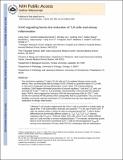OX40 signaling favors the induction of TH9 cells and airway inflammation

View/
Author
Xiao, Xiang
Balasubramanian, Savithri
Liu, Wentao
Chu, Xiufeng
Taparowsky, Elizabeth J.
Fu, Yang-Xin
Choi, Yongwon
Walsh, Matthew C.
Li, Xian Chang
Published Version
https://doi.org/10.1038/ni.2390Metadata
Show full item recordCitation
Xiao, Xiang, Savithri Balasubramanian, Wentao Liu, Xiufeng Chu, Haibin Wang, Elizabeth J. Taparowsky, Yang-Xin Fu, Yongwon Choi, Matthew C. Walsh, and Xian Chang Li. 2012. “OX40 signaling favors the induction of TH9 cells and airway inflammation.” Nature immunology 13 (10): 981-990. doi:10.1038/ni.2390. http://dx.doi.org/10.1038/ni.2390.Abstract
The mechanisms regulating T helper 9 (TH9) cells and TH9-mediated diseases remain poorly defined. Here, we demonstrate that the receptor OX40 (Tnfrsf4) is a powerful inducer of TH9 cells in vitro and TH9-dependent airway inflammation in vivo. Under TGF-β based polarizing conditions, OX40 ligation eliminated production of induced regulatory T cells and TH17 cells, and divertedCD4+Foxp3− T cells to a TH9 phenotype. Mechanistically, OX40 activated the ubiquitin ligase TRAF6, which triggered the induction of NF-kB-inducing kinase (NIK) in CD4+ T cells and the non-canonical NF-kB pathway which subsequently lead toTH9 generation. Thus, our study identifies a previously unknown mechanism of TH9 induction and may have important clinical implications in allergic inflammation.Other Sources
http://www.ncbi.nlm.nih.gov/pmc/articles/PMC3806044/pdf/Terms of Use
This article is made available under the terms and conditions applicable to Other Posted Material, as set forth at http://nrs.harvard.edu/urn-3:HUL.InstRepos:dash.current.terms-of-use#LAACitable link to this page
http://nrs.harvard.edu/urn-3:HUL.InstRepos:11878907
Collections
- HMS Scholarly Articles [17922]
Contact administrator regarding this item (to report mistakes or request changes)


